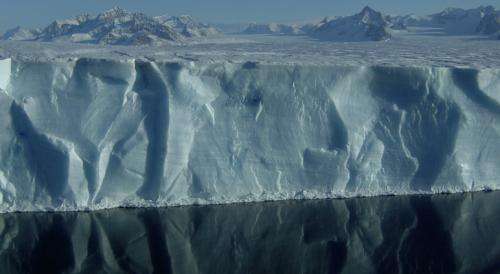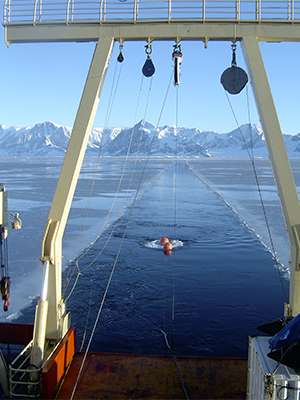September 12, 2014 report
Study shows above ice warming responsible for Larsen-B Ice Shelf collapse, not instability

(Phys.org) —An international team of researchers has concluded that the Larsen-B Ice Shelf collapsed in 2002 because of warmer surface air temperatures, not instability from below, as some have suggested. In their paper published in the journal Science, the team describes how they collected and examined sea floor samples in the area where Larsen-B collapsed and found no evidence of structural damage that could have caused the shelf to collapse—that leaves warmer temperatures from above as the only logical cause.
An ice shelf forms when a glacier slides from land to the sea—because the seawater is near freezing, the ice floats on the surface. But a part of the shelf, very near the shore (the grounding line), does touch the seafloor, and that's where the researchers focused their attention. When Larsen-B suddenly cracked apart into pieces that drifted into the open ocean, most experts believed it was because sea water temperatures had increased to the point where the water could no longer support the ice above it. In this new effort, the researchers looked at the former grounding line of Larsen-B by taking core samples from a ship above it. In so doing, they found that the grounding line hadn't moved in over 12,000 years making it highly unlikely that loss of support from below was the reason for the collapse.
Temperatures from above can cause a collapse when they increase to the point that ice on top of the shelf melts, forming pools of water. Those pools cause the ice beneath them to melt, allowing the water in the pool to seep down, eventually forming crevices. As the crevices grow bigger, they can cause pieces of the shelf to break off in much the same way that cracks on the outlying edges can cause calving to occur. Notably, an ice shelf breaking off doesn't cause a rise in sea levels because it was already floating on top. Quite often it does lead to a speed up of the glacier flowing into the sea, however, and that does cause sea levels to rise.

The researchers believe their findings will help to identify which ice shelves are likely to break apart in the near future, helping to make better estimates on how much sea levels will rise, and when, due to global warming.
More information: Boundary condition of grounding lines prior to collapse, Larsen-B Ice Shelf, Antarctica, Science 12 September 2014: Vol. 345 no. 6202 pp. 1354-1358, DOI: 10.1126/science.1256697
ABSTRACT
Grounding zones, where ice sheets transition between resting on bedrock to full floatation, help regulate ice flow. Exposure of the sea floor by the 2002 Larsen-B Ice Shelf collapse allowed detailed morphologic mapping and sampling of the embayment sea floor. Marine geophysical data collected in 2006 reveal a large, arcuate, complex grounding zone sediment system at the front of Crane Fjord. Radiocarbon-constrained chronologies from marine sediment cores indicate loss of ice contact with the bed at this site about 12,000 years ago. Previous studies and morphologic mapping of the fjord suggest that the Crane Glacier grounding zone was well within the fjord before 2002 and did not retreat further until after the ice shelf collapse. This implies that the 2002 Larsen-B Ice Shelf collapse likely was a response to surface warming rather than to grounding zone instability, strengthening the idea that surface processes controlled the disintegration of the Larsen Ice Shelf.
Journal information: Science
© 2014 Phys.org


















